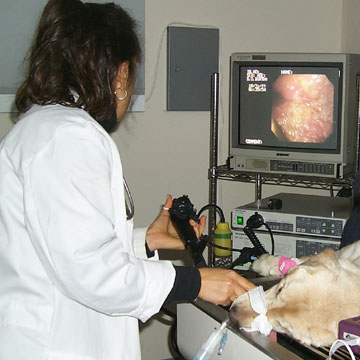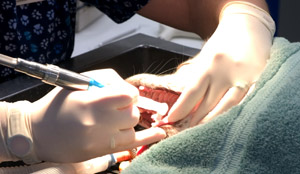Pet Diagnostics: The Benefits of Endoscopy
Endoscopy is a minimally invasive diagnostic medical procedure commonly used to evaluate the interior surfaces of an organ by inserting a small tube into the body. Through the endoscope, the observer is able to see lesions of organs and other internal medical conditions. Endoscopy means "looking inside."
In veterinary medicine, endoscopy is commonly used as a diagnostic procedure, for tissue and organ biopsies, to remove foreign objects (particularly in the stomach) or get an inside view of a particular part of your pet's body. Even though anesthesia is required to keep your pet still during the endoscopic procedure, the amount of anesthesia and recovery time is greatly reduced. Literally meaning "to look within," endoscopy is often indicated when routine blood and urine tests, radiographs and ultrasound do not give the complete diagnostic picture.
The endoscope is composed of a long tube (flexible or rigid), a light source, camera and viewing eyepiece. In addition to the fiber optic light source, there are two channels within in the tube. One channel is for passing forceps, snares or biopsy instruments, allowing for the removal of foreign objects, collection of biopsy samples and removal of small polyps or tumors. Air or water can be passed through the other channel for better viewing of the tissue or organ.

One can distinguish:
• The endoscope itself, consisting of either a rigid or flexible tube
• A light delivery system to illuminate the organ or object under inspection
• A lens system transmitting the image to the viewer from the fiberscope
• An additional channel to allow entry of medical instruments to biopsy or to facilitate tissue and other operations
The benefits of endoscopy include shortened anesthetic time, decreased inflammation, less physiologic stress and discomfort and an earlier return to normal function. The endoscope is used to help diagnose and treat a variety of gastrointestinal and respiratory disorders. Depending on the symptoms, it is used to look at the inner lining of the throat, stomach, intestine, colon or at the respiratory passages (nose, throat and lungs). Even though general anesthesia is required for an endoscopic procedure, it is still considered much less invasive than traditional surgery, due to the relatively short procedure length and low occurrence of complications.
Excellent Dental Care for Your Pet
A complete examination of all surfaces of the teeth is impossible to perform while the veterinary patient is awake. The external surface of some teeth may be superficially examined, but the inside surfaces of the teeth (within the oral cavity) cannot be evaluated unless anesthesia or deep sedation is administered.
Laboratory blood tests along with an ECG and radiographs are often necessary before a dental patient can be anesthetized. The older the patient, the more tests that may be needed prior to administering general anesthesia. Animals with congenital disease and pets suffering from chronic conditions are a greater anesthetic risk than completely healthy pets. If your pet is considered an anesthetic risk, your veterinarian will recommend the tests that are necessary prior to administering anesthesia.
The anesthesia given to one pet may be completely different than the anesthesia given to another pet. Your veterinarian can choose from a variety of pre-anesthetic medications and anesthesia induction agents. After the pre-anesthesia medication and induction agents are administered, general anesthesia is usually maintained with a gas agent (isoflurane or sevoflurane) mixed with oxygen. Monitoring the anesthetized patient is a fundamental procedure in veterinary medicine.

One or more of the following monitors may be used:
• Electronic Respiratory Monitor
• Pulse Oximeter
• Blood-Pressure Monitor
• Electrocardiograph (ECG)
• Esophageal Stethoscope
• Carbon Dioxide Monitor
Along with patient monitoring, it is important to keep the pet warm and comfortable during the dental procedure. Since many procedures may last longer than an hour, the pet's core body temperature may become lowered. By using blankets, hot water bottles and heated tables, the veterinary patient's body temperature can be maintained at its normal value.
Anesthesia or deep sedation is necessary for oral examination and dental cleaning because:
• Dental tartar is firmly attached to the surface of teeth and needs to be removed.
• Scaling by ultrasonic scalers and sharp hand instruments are necessary in order to remove the dental tartar.
• Any sudden movement can cause injury to the animal or individual performing the dental procedure.
• Dental scaling is performed above and below the gum line. Scaling the teeth above the gum line usually does not cause discomfort, however, scaling below the gum line (can cause discomfort. The area below the gum line, or subgingival space, is the most important area to clean as periodontal disease begins here.
• Humans cooperate during dental procedures, however without anesthesia or deep sedation, dogs and cats do not.
• Scaling above the gum line offers nothing but cosmetic results. Scaling must be done below the gum line.
During the last few years, veterinary dentistry has made tremendous strides. By taking advantage of the dental procedures offered at your veterinary hospital, your pet can enjoy the benefits of having excellent teeth well into his or her senior years.





